1930s Overview
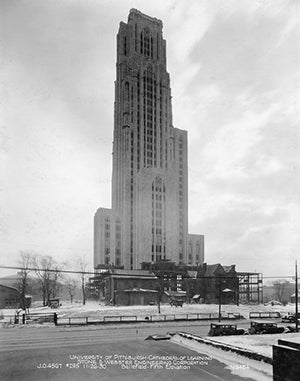
In the 1930s, the English department continued its close ties to Chancellor Bowman and the Bowman administration. It was also a decade of change, some of it fairly dramatic. Like the Cathedral of Learning, the department was still a work in progress.
The graduate program grew significantly. Percival Hunt continued to recruit nationally and to hire regularly. In fact, Bowman, on behalf of the department, wrote to Robert Frost to see if he might be interested in joining the faculty. Agnes Lynch Starrett, now an Assistant Professor of English, was commissioned to write the history of the university, Through One Hundred and Fifty Years: The University of Pittsburgh, a book that celebrates the university and its mission in the region. William Don Harrison, an Associate Professor of English, was appointed Athletic Director in 1928 and was responsible for athletics during the peak years of the Jock Sutherland era, an era that included a win at the Rose Bowl in 1937 and efforts to replace Chicago in the Big Ten. (Harrison was to resign the position in 1937, when he, representing the Chancellor, and Sutherland were locked in battle over funding for athletics. Sutherland would resign in 1939, creating substantial controversy and attracting the attention of the national press.)
In the late 1920s, Speech, Debate and Theater had become a “division” of the department, with separate course listings. In the 1930s, there was substantial turnover among the faculty in these areas, surely a sign of conflict and dissention, and, by the end of the decade, the division was growing in importance and in course enrollments. The faculty in this area wanted more independence. In the next decade, it would break away from English to become a separate, free-standing Speech Department. In 1935, in a reverse move, the Department of Journalism, originally in the School of Economics, became a division of English headed by an Instructor, Robert X. Graham, who was also responsible for student publications. The 1930s saw the first course in Linguistics and the first course on Children’s Literature.
In the 1930s, the department was still being shaped by Percival Hunt’s distinctive style and his determined vision of an undergraduate education centered on “writing and reading.” Here, to close this overview, is Hunt describing the department in a 1934 report to the Dean of the College:
The chief occupation of the Department of English and, I suppose, its chief distinction, is trying to show nine thousand students each year what is good writing and what is good reading. We do this at almost all times and in almost all places. English is taught on the Campus during the year and in the Summer, in Extension, in the Downtown Division, and in the junior college centres. In the Summer, for instance, we have about nine varieties of Summer session. This that I have called writing and reading is not so simple as it seems, for it includes an attempt to have the student realize the world he has grown up in, the world in which he is living, and form some standards of taste and judgment about places, and people, and ideas among which he has moved or will have to move. Perception, good taste, good judgment, and clear expression—these about sum-up what the Department of English is trying to do.
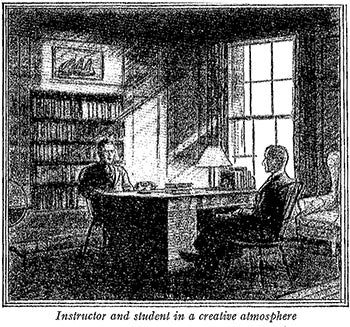
From a 1934 Fund Raising Campaign
I have not said anything about research because research in English is pretty much a graduate occupation. We have about four hundred graduate students each year. In the past nine years, the University has granted in English one hundred and forty-two master of arts degrees and thirteen doctoral degrees. Most of these students are teaching in high schools. There is scarcely a high school in the western part of the state and none in Pittsburgh in which our graduates are not teaching. Many of them, however, are teaching in colleges, in Antioch College, Queens College (North Carolina), California State Teachers College, University of New Mexico, Wittenberg College, Geneva College, Seton Hall College, Mt. Union College (two), Western Reserve University, Mt. Mercy College, Seton Hill College, Pennsylvania College for Women, Lehigh College, Virginia State College, University of Michigan, National University of China, Budapest (Hungary) National Gymnasium, Indiana State Teachers College, Johnson C. Smith University, Lincoln Memorial University, University of Hawaii, Kansas State College, Syracuse University, Washington University, Arnold School, and the University of Pittsburgh. Besides, among holders of graduate degrees in English are ministers, housewives, and business men.
Public Speaking, especially debating, is done most directly in front of the public. This year, for instance we have had, roughly, one hundred debates, many of them before chambers of commerce, women’s clubs, and discussions groups, as well as before college audiences. The debating teams have met schools from Canada to Cuba, and from Maine to Washington.
1930s Courses
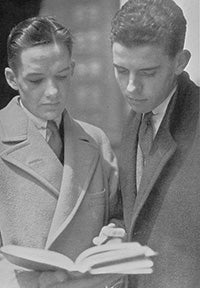
In the decade of the 1930s, the English department added a course in descriptive linguistics, “The English Language,” taught by Putnam Fennel Jones, and a course in children’s literature, “Child Literature,” designed for students in Elementary Education and taught by Emily Gertrude Irvine. The graduate program grew substantially. Graduate students were primarily taking upper division undergraduate courses. The graduate-only curriculum was small and included “Introduction to Graduate Work” (Myers), “Graduate Problems” (Hunt and Staff), “Problems of College English” (Hunt), and a substantial series of courses in Old and Middle English (taught by Putnam Fennel Jones and John Kemerer Miller).
Literature: There was a required sophomore survey course, “from Chaucer to Hardy,” with the stipulation that “The work of the student is commonly presented in writing” and “No student succeeds in this course who cannot express his ideas clearly and correctly.” In the upper division, the English department curriculum provided a full list of survey, period, and genre courses in English and American Literature, including Old English and Contemporary American. There were, in addition, several courses in Literary Criticism, including “Literary Criticism,” “Survey of Criticism,” and a course in “Problems in Criticism and Literary History” open to a focus chosen by individual members of the faculty—for example, “Late Nineteenth Century Novel” (Walter Lawrence Myers) and “The Eighteenth Century” (Frederick Philip Mayer). George Carver introduced a course in “English Biography.”
The department added two courses for “seniors in the technical schools.” Both were called “English for Technical Students”—one was designated for students who “wish to improve their acquaintance with English literature”; the other (directed to students in Engineering) offered “practice in writing” along with “readings in contemporary prose.”
Composition and Writing: The required first year course, “English Composition,” was a four credit course, with three classroom hours and an hour of conference. This was supplemented by “Composition Review,” a 2 or 4 credit course for students who needed “additional training.” There were advanced courses in “Special English Composition (“for teachers or English majors who wish additional practice”) and “Expository Writing.” Percival Hunt (and others, including Ed Peterson) offered advanced composition courses titled “Essay and Narrative,” “Description and Narrative,” and “Special English,” the latter most likely small workshop courses. Hunt’s interest in the literary essay defied any strict division of Composition and Creative Writing.
In the 1930s, the department continued to offer a course in writing the Short Story, and in 1939 one of Edwin Peterson’s students won 6th prize in the Story Magazine student writing contest. There appear to have been no courses in the writing of poetry. Hunt and Peterson and others (like George Gerwig, for example) sponsored writing workshops where students gathered to present and discuss their work. There was not now, nor had there yet been, a Creative Writing faculty or an independent listing of courses in Creative Writing. There were, rather, faculty who were interested in student writing across genres, and they tended to teach the advanced courses. In the 30s, the upper division in English included advanced, elective courses called “English Writing,” advertised for students who “like to write.” Genre is not indicated in the course titles. By the end of the decade, once Journalism was established as a Division of the department, courses were offered in reporting and in feature and editorial writing.
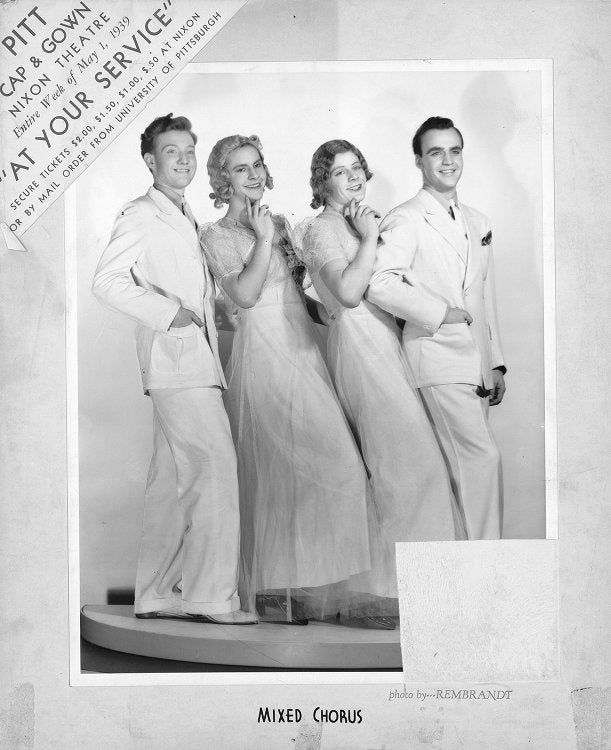
Public Speaking: Courses in public speaking, debate and oral interpretation are now supplemented by courses in acting, voice training, and theater production. Several members of the faculty are engaged with theater on campus and in the city. Buell Whitehill, a Yale Theater MFA, joined the department in 1939 and soon became closely involved with the Pitt Players, the student theater group. He would later teach courses in Film History.
In the decade of the 1930s, there was substantial turnover among the faculty teaching in this division, faculty with commitments to rhetoric, theater, debate, and oral interpretation, surely a sign of conflict and dissention. By the end of the 1930s, the division of Public Speaking was preparing to break away from English to become a separate, free-standing Speech Department. Hunt and those most closely affiliated with him were clearly interested in text rather than performance. This was also a period of political unrest on campus, most of it directed toward charges that Chancellor Bowman was unduly restricting the academic freedom of the faculty in discussions of politics and the economy. Whatever the causes, faculty in this area were leaving the university or, when they stayed, looking for a new academic home.
1930s Faculty
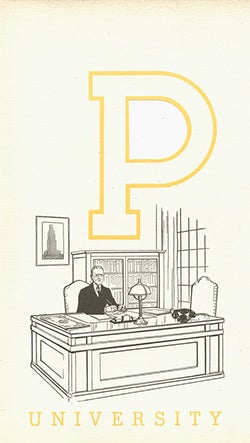 Percival Hunt: Professor and Chair. In 1929, Percival Hunt self-published An Outline of Composition and this document had some national circulation, since it is cited in the English Journal. The Outline represented the “aims and plan” for English 1 and English 2, the two semester composition sequence at the University of Pittsburgh. It also includes “Four Lessons on Poetry.” The Outline is detailed, sometimes obsessively so, and is organized in predictable terms: sentences, paragraphs, essays; description, narration, argumentation. This curriculum is most likely the origin for what became known as the “Pittsburgh Paragraph,” a term used sometimes with admiration and sometimes with scorn, particularly by later generations of faculty. Hunt also published an annual collection of “Student Themes.” This is a cumulative anthology, a collection of student writing over time rather than the best essays of each academic year. Most likely it was used as a text in undergraduate courses. The student essays provide a different and much richer view of undergraduate writing at the University of Pittsburgh. If the Outline now appears to be predictable, the student essays, although written within the classroom genres of the period, are smart, inventive, charming, compelling and sometime surprising. They are perhaps a better index into the ways writing was valued and promoted in the English department.
Percival Hunt: Professor and Chair. In 1929, Percival Hunt self-published An Outline of Composition and this document had some national circulation, since it is cited in the English Journal. The Outline represented the “aims and plan” for English 1 and English 2, the two semester composition sequence at the University of Pittsburgh. It also includes “Four Lessons on Poetry.” The Outline is detailed, sometimes obsessively so, and is organized in predictable terms: sentences, paragraphs, essays; description, narration, argumentation. This curriculum is most likely the origin for what became known as the “Pittsburgh Paragraph,” a term used sometimes with admiration and sometimes with scorn, particularly by later generations of faculty. Hunt also published an annual collection of “Student Themes.” This is a cumulative anthology, a collection of student writing over time rather than the best essays of each academic year. Most likely it was used as a text in undergraduate courses. The student essays provide a different and much richer view of undergraduate writing at the University of Pittsburgh. If the Outline now appears to be predictable, the student essays, although written within the classroom genres of the period, are smart, inventive, charming, compelling and sometime surprising. They are perhaps a better index into the ways writing was valued and promoted in the English department.
Walter Lawrence Myers: Professor of English.
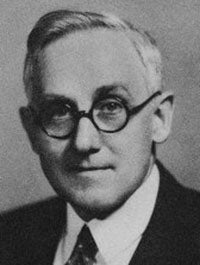 John Kemerer Miller (1880-1949). J. K. Miller was promoted to the rank of Professor in 1930. He began his career in the English department in 1911 and taught until his retirement in 1945. He held a BA from Mount Union College (1908). He had no advanced degrees, although he spent short periods of study at Harvard and Oxford. In a tribute to Miller, his colleague, H.W. Schoenberger, said: “[Miller] joined the English staff in 1911 when the university was small, serving mainly local needs. He lived to see it become a metropolitan institution of national prominence and prestige. He took a personal pride and pleasure in its growth, and he may well have felt that he made a modest contribution to its development. His loyalty and devotion to the University were unreserved.” Miller taught courses on Bacon, Spenser, Ruskin and Chaucer.
John Kemerer Miller (1880-1949). J. K. Miller was promoted to the rank of Professor in 1930. He began his career in the English department in 1911 and taught until his retirement in 1945. He held a BA from Mount Union College (1908). He had no advanced degrees, although he spent short periods of study at Harvard and Oxford. In a tribute to Miller, his colleague, H.W. Schoenberger, said: “[Miller] joined the English staff in 1911 when the university was small, serving mainly local needs. He lived to see it become a metropolitan institution of national prominence and prestige. He took a personal pride and pleasure in its growth, and he may well have felt that he made a modest contribution to its development. His loyalty and devotion to the University were unreserved.” Miller taught courses on Bacon, Spenser, Ruskin and Chaucer.
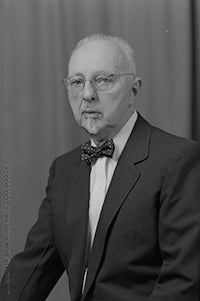 Wayland Maxfield Parrish. In 1930, Parrish promoted to the rank of Full Professor and appointed head of the department’s Division of Public Speaking. Parrish was an important and influential figure on campus. The William Pitt Debating Union continues to sponsor a Wayland Maxfield Parrish award. He was the first of many colleagues to come from Cornell and Cornell’s famous 1920s rhetoric program. Parrish was the author of a classic essay in his field, “The Study of Speech,” included in the book, American Speeches, prepared with his student, Marie Hochmuth (Nichols). Parrish was also the author of The Teacher’s Speech (1939), Reading Aloud: A Technique in the Interpretation of Literature (1941), Speaking in Public (1947, with Richard Murphy), and A Series of Six Radio Talks on Public Speaking (1926). In 1936, Parrish left the University of Pittsburgh to take a position at the University of Illinois where he taught until his retirement in 1955.
Wayland Maxfield Parrish. In 1930, Parrish promoted to the rank of Full Professor and appointed head of the department’s Division of Public Speaking. Parrish was an important and influential figure on campus. The William Pitt Debating Union continues to sponsor a Wayland Maxfield Parrish award. He was the first of many colleagues to come from Cornell and Cornell’s famous 1920s rhetoric program. Parrish was the author of a classic essay in his field, “The Study of Speech,” included in the book, American Speeches, prepared with his student, Marie Hochmuth (Nichols). Parrish was also the author of The Teacher’s Speech (1939), Reading Aloud: A Technique in the Interpretation of Literature (1941), Speaking in Public (1947, with Richard Murphy), and A Series of Six Radio Talks on Public Speaking (1926). In 1936, Parrish left the University of Pittsburgh to take a position at the University of Illinois where he taught until his retirement in 1955.
Harold William Schoenberger. In the 1930s, Schoenberger taught drama and American literature. With his colleague, Ralph Ware, and with Richard P. Smith he edited a volume, The Sentinels & Other Plays in the series, America’s Lost Plays (Princeton, 1941).
George Carver: Promoted to Professor in 1931.
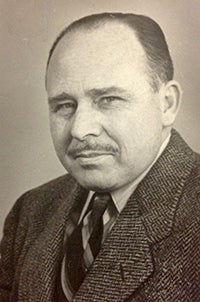 William Don Harrison: Associate Professor. Harrison, who was promoted to Associate rank at the end of the 1920s, was another member of the English department drawn from English department at the University of Iowa (A.B., University of Iowa, 1916; A.M., University of Iowa, 1921). He served as the Dean of Men. In 1928, Harrison became the University’s Director of Athletics. He was, then, responsible for athletics during the peak years of the Jock Sutherland era, an era that included a win at the Rose Bowl in 1937, national success in basketball, track and swimming, and when Pitt was trying to position itself to replace Chicago in the Big Ten. Harrison was to resign the position in 1937, when, representing the Chancellor, he and Sutherland were locked in a battle over funding for athletics, a battle over the sources as well as the levels of funding. Harrison left Oakland to teach at the University’s Erie extension campus and then at Johnstown, but he remains on the English department roster and returns to teach in Oakland at a later date.
William Don Harrison: Associate Professor. Harrison, who was promoted to Associate rank at the end of the 1920s, was another member of the English department drawn from English department at the University of Iowa (A.B., University of Iowa, 1916; A.M., University of Iowa, 1921). He served as the Dean of Men. In 1928, Harrison became the University’s Director of Athletics. He was, then, responsible for athletics during the peak years of the Jock Sutherland era, an era that included a win at the Rose Bowl in 1937, national success in basketball, track and swimming, and when Pitt was trying to position itself to replace Chicago in the Big Ten. Harrison was to resign the position in 1937, when, representing the Chancellor, he and Sutherland were locked in a battle over funding for athletics, a battle over the sources as well as the levels of funding. Harrison left Oakland to teach at the University’s Erie extension campus and then at Johnstown, but he remains on the English department roster and returns to teach in Oakland at a later date.
Ellen Mary Geyer: Geyer was promoted to Associate Professor in 1932.
Ford Elmore Curtis (1895-1979) completed his BA at Oberlin in 1918 and his MA in drama at the University of Michigan in 1924, when he joined the faculty in English at the University of Pittsburgh as an Instructor and where he helped to open the Johnstown campus. He left for graduate study at Cornell, where he completed his PhD in 1931. In 1931 he returned to the University of Pittsburgh English department. He was promoted to Associate Professor in 1939 and Professor in 1949. He retired in 1961. With his wife, Harriet Ralston Curtis, he amassed a substantial collection of theater books, programs and memorabilia, which is now housed as the “Curtis Theater Collection” in the Hillman Library.
Putnam Fennell Jones: Jones was hired as an Assistant Professor in 1930 and promoted to Associate rank in 1932. Like Maxwell Parrish and Hoyt Hudson, Jones comes from the rhetoric program at Cornell (BA, Cornell, 1924; MA, Cornell, 1926; PhD, Cornell, 1927). His declared areas of specialty were “English language” and “early English literature.” By the end of the 30s, he had published essays in Modern Language Notes and other professional journals, and a book, A Concordance to the Historia Ecclesiastica of Bede. Jones, whose career in the department extends into the 60s, will later become Chair of the English department and Dean of the Graduate School. In 1931, he published an essay in the Pittsburgh Record (the alumni magazine) on American dialects, “What English Do You Speak?”
Frederick Philip Mayer was promoted to Associate Professor in 1936. Mayer wrote regularly for local newspaper and university publications. In 1930, for example, he published an essay, “A Day in Old Allegeny,” in the Pittsburgh Record, the alumni magazine. Mayer completed his BA and MA at the University of Pittsburgh. Although he never completed a more advanced degree, he was a prominent figure and he had a long and distinguished record at the University of Pittsburgh, including service as English department chair.
Ralph Hartman Ware: Ware was promoted to Associate Professor in 1931.
John Wendell Dodds: (BA Wooster, 1924; MA and PhD Yale, 1927, 1932.) Dodds was hired as an Assistant Professor in 1930 and promoted to Associate in 1935. In 1937 he left to take a position at Stanford, where he ended his career as the Jackson Eli Reynolds Professor Humanities. He also served as Stanford’s Dean of Humanities and as the Founder and Director of Special Programs in the Humanities. He was actively involved in bringing educational program to TV, including “The Measure of Man” (KQED/NET, 1957) and, in 1959-60, twelve films for the National Educational TV Center in New York. These were later published as the book, American Memoir (1961). Dodds acted in local theater. He was the author of Thomas Southerne, Dramatist (1933), Thackeray, A Critical Portrait (1941), The Age of Paradox: A Biography of England, 1841-51 (1952), The Several Lives of Paul Fejos (1963). He also served as an editor of An Oxford Anthology of English Prose (1935), Types of English Fiction (1940), and British and American Plays, 1830-1945 (1947).
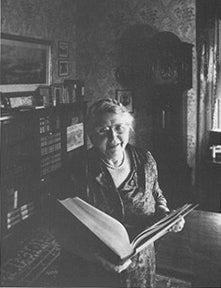 Agnes Lynch Starrett: (BA, University of Pittsburgh, 1920; MA, University of Pittsburgh, 1925). Instructor in English, promoted to Assistant Professor in 1935. Starrett had a long and distinguished career in our department. She was promoted to Associate Professor in 1944 and Full Professor in 1955. She retired in 1964. In 1936, Chancellor Bowman commissioned Starrett to write a history of the university in celebration of its 150th anniversary, Through 150 Years: The History of the University of Pittsburgh (Pittsburgh UP, 1937). This is the first book published by the University of Pittsburgh Press. In 1938, she became the first editor of Pitt Magazine, a position which she held for 20 years. She also served as the faculty supervisor for the student yearbook, The Owl. Throughout her career, Starrett taught courses in composition, in writing, and in literature. In 1954, she became the Director of the University of Pittsburgh Press. In 1986, she was awarded the University of Pittsburgh’s Medallion of Distinction; in 1987 she was named a Distinguished Alumna. She was awarded an Honorary Doctorate from Waynesburg College. The University of Pittsburgh Press continues to award the very distinguished Agnes Lynch Starrett Poetry Prize for a first book of poems.
Agnes Lynch Starrett: (BA, University of Pittsburgh, 1920; MA, University of Pittsburgh, 1925). Instructor in English, promoted to Assistant Professor in 1935. Starrett had a long and distinguished career in our department. She was promoted to Associate Professor in 1944 and Full Professor in 1955. She retired in 1964. In 1936, Chancellor Bowman commissioned Starrett to write a history of the university in celebration of its 150th anniversary, Through 150 Years: The History of the University of Pittsburgh (Pittsburgh UP, 1937). This is the first book published by the University of Pittsburgh Press. In 1938, she became the first editor of Pitt Magazine, a position which she held for 20 years. She also served as the faculty supervisor for the student yearbook, The Owl. Throughout her career, Starrett taught courses in composition, in writing, and in literature. In 1954, she became the Director of the University of Pittsburgh Press. In 1986, she was awarded the University of Pittsburgh’s Medallion of Distinction; in 1987 she was named a Distinguished Alumna. She was awarded an Honorary Doctorate from Waynesburg College. The University of Pittsburgh Press continues to award the very distinguished Agnes Lynch Starrett Poetry Prize for a first book of poems.
W. George Crouch was appointed as an Assistant Professor in 1937. Crouch, a native of London, England, received his BA and MA from the University of Pittsburgh (1925, 1927) and his PhD from Princeton (1937). He was promoted to Associate Professor in 1944, to the rank of Professor in 1950, and was named department chair in 1955. In the 1930s, he taught composition and technical writing.

Edwin L. Peterson: Edwin (Pete) Peterson was a protégé of Percival Hunt. He received his BA and MA in English at the University of Pittsburgh (1926, 1928). He would later be the lead faculty member in the Composition Program and play an important role in the developing courses in fiction and literary nonfiction in the Creative Writing program. Peterson was promoted to Assistant Professor in 1935. In 1939, he developed a new course, “Conference in Writing,” that met in the Early American Nationality room. This was a space he was to make his own for many years. In this course, 15 students met regularly to share work in progress—poetry, fiction and nonfiction. According to Peterson, in this course “students are really writing, not just talking about it; and it is only by writing, I am convinced, that students learn how to put a story together or how to make a poem truly sing.” An evening section was offered for local journalists.
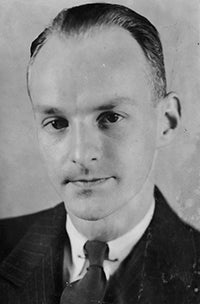 Buell B. Whitehill, Jr. In 1939 Whitehill joined the English department as an Assistant Professor. He earned an MFA in theater from Yale and brought experience and interest in theater production to a faculty with an already substantial interest in the dramatic arts and literature. Whitehill was Director of the Pitt Players and very active in campus theater. In 1935, he published A Project for the Lighting of Parsifal with Yale University Press. Whitehill also developed courses in film and film history. He could, then, be said to be the first to introduce the study of film to our department. In 1951, he organized an interdisciplinary symposium on “The Role of Communications in Human Relations,” drawing faculty from Speech, Sociology, Psychology and Journalism. Whitehill was part of a successful movement to create a separate, free standing Department of Speech, a department he chaired until 1953.
Buell B. Whitehill, Jr. In 1939 Whitehill joined the English department as an Assistant Professor. He earned an MFA in theater from Yale and brought experience and interest in theater production to a faculty with an already substantial interest in the dramatic arts and literature. Whitehill was Director of the Pitt Players and very active in campus theater. In 1935, he published A Project for the Lighting of Parsifal with Yale University Press. Whitehill also developed courses in film and film history. He could, then, be said to be the first to introduce the study of film to our department. In 1951, he organized an interdisciplinary symposium on “The Role of Communications in Human Relations,” drawing faculty from Speech, Sociology, Psychology and Journalism. Whitehill was part of a successful movement to create a separate, free standing Department of Speech, a department he chaired until 1953.
Charles Arnold: He continued to remain at the rank of Assistant Professor through the decade of the 30s. He had taught Journalism and supervised student publications for years. It is surprising, then, that he was not given charge of Journalism when it became a Division of the English department.
Justus Howard Dice: Dice (BA, University of Pittsburgh; B.L.S., New York State Library School, 1913) was hired as an Assistant Professor of Bibliography. He became University Librarian in 1939.
Carson Crandall Hamilton: (MA, University of Pittsburgh). Hamilton joined the department as an Acting Assistant Professor of English in 1930. He left in 1933.
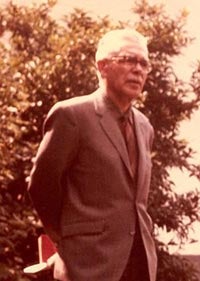 Marvin Theodore Herrick: Herrick is another of several Cornell PhDs hired to the English department. His specialties were drama and 18th century literature. Like several of his colleagues, Herrick was an actor and involved in local theater. With Hoyd Hudson (under the joint pseudonym John Smith), he was the author of two one-act plays, “The Upper Forty” and “Out of the Night.” Through the university’s program with KDKA, he presented and then published Ten Radio Talks on the One Act Play (U of Pittsburgh Press, 1930). While at Pitt, he published The Poetics of Aristotle in England (Yale UP, 1930) and, for the Pittsburgh Journal (the alumni magazine), an essay on the consequences for the stage of the new medium of cinema, “A New Method of Acting.” Herrick left the department in 1934 for George Washington University, although he spent most of his career at the University of Illinois (1937-1966), where he was Professor of English and Associate Dean of Arts and Sciences. His other publications include: Eleven British Writers (with Charles Osgood, 1940), The Fusion of Horation and Aristotelian Literary Criticism (1946), Comic Theory in the Sixteenth Century (1950), Tragicomedy: Its Origin and Development in Italy, France, and England (1956), Italian Comedy in the Renaissance (1960), Italian Tragedy in the Renaissance (1965), an anthology, Italian Plays, 1500-1700 (1966), and a critical edition of Wicherley’s The Country Wife (1967).
Marvin Theodore Herrick: Herrick is another of several Cornell PhDs hired to the English department. His specialties were drama and 18th century literature. Like several of his colleagues, Herrick was an actor and involved in local theater. With Hoyd Hudson (under the joint pseudonym John Smith), he was the author of two one-act plays, “The Upper Forty” and “Out of the Night.” Through the university’s program with KDKA, he presented and then published Ten Radio Talks on the One Act Play (U of Pittsburgh Press, 1930). While at Pitt, he published The Poetics of Aristotle in England (Yale UP, 1930) and, for the Pittsburgh Journal (the alumni magazine), an essay on the consequences for the stage of the new medium of cinema, “A New Method of Acting.” Herrick left the department in 1934 for George Washington University, although he spent most of his career at the University of Illinois (1937-1966), where he was Professor of English and Associate Dean of Arts and Sciences. His other publications include: Eleven British Writers (with Charles Osgood, 1940), The Fusion of Horation and Aristotelian Literary Criticism (1946), Comic Theory in the Sixteenth Century (1950), Tragicomedy: Its Origin and Development in Italy, France, and England (1956), Italian Comedy in the Renaissance (1960), Italian Tragedy in the Renaissance (1965), an anthology, Italian Plays, 1500-1700 (1966), and a critical edition of Wicherley’s The Country Wife (1967).
Benjamin Thomas McClure: Assistant Professor. McLure died in 1932. In a 1930 issue of The Pittsburgh Record (the alumni magazine), McLure published an essay on the literature of World War One, “A Ray of Hope for Peace.”
Clarke Olney: Acting Assistant Professor. Olney left the department in 1938.
Henry Clayton Fisher: (BA, Pittsburgh 1928; MA Pittsburgh 1930). Fisher was promoted from Instructor to Assistant Professor in 1938.
Carl B. Cass: Assistant Professor (PhD Wisconsin) joined the department in 1930. He taught Speech and Theater and served as Director of the Pitt Players. He left the department in 1935.
Instructors: There were 10-15 non tenure track instructors on the roster each year throughout the 1930s. There was substantial turnover, so we won’t list them all. Those who held Pitt degrees are:
George W. Gerwig: Ph.D., 1904. Gerwig, a businessman and educator in Pittsburgh, taught fiction writing courses in the evening and extension divisions.
James Stewart Hunter: BA, 1929. In 1931, Hunter published an essay on “Some Pittsburgh Authors” in The Pittsburgh Journal (the alumni magazine).
Emily Gertrude Irvine: MA, 1928. Irvine introduced courses in “Child Literature” to the curriculum in the 1930s. She went on to a long career at Pitt.
Alma Carlson: BA, 1926
Frank Daniel Curtin: BA, 1927; MA, 1929
Emily Hall Duffus: BA, 1927; MA, 1928
James McHugh Flanagan: BA, 1926; MA, 1928
Theresa Kahn: BA, 1925
Richard Murphy: BA, 1927; MA, 1928
Francis Beall Stone: BA, 1926; MA, 1930
Charlotte McMurray Kidney: BA, 1928
Others with years of service include:
Robert X. Graham: Graham, who was hired in 1935, became the Director of Journalism and Student Publications.
Frederick James Gilsdorf
Elmer Sandfrid Osberg
Doren Tharp
Hugh Allen Wing
1930s Students
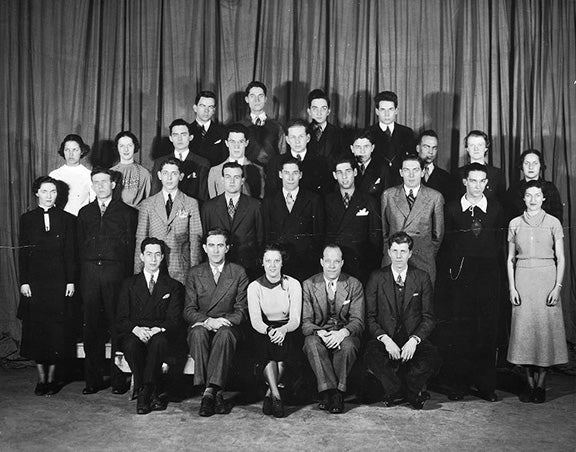
Undergraduates
Rose Marie Demestichas (BA class of 1933) was the President of the Women’s Self-Governing Assembly. After earning her BA, she completed an MA in English at Pitt and then went to work for the Public Housing Authority in Pittsburgh, where she served as a manager of Terrace Village. In 1933 she published an essay, “Why I Go to College,” for a collection of essays on “What College Means” published in the Pittsburgh Record (the alumni magazine).
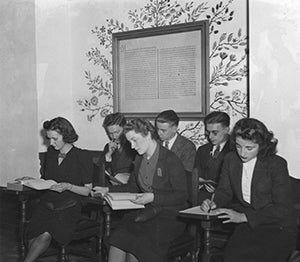
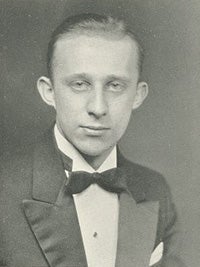 Robert C. Machesney (BA class of 1932) was the editor of the Pitt Weekly, a student-run magazine that followed the Courant. After graduation, Machesney became an instructor in Journalism at Pitt and was hired by Agnes Lynch Starrett as an adviser to student publications. He left the University in 1942 to take an appointment in Military Intelligence with the War Department. In 1933, he also published an essay on his college experience, “After Four Years,” in the Pittsburgh Record.
Robert C. Machesney (BA class of 1932) was the editor of the Pitt Weekly, a student-run magazine that followed the Courant. After graduation, Machesney became an instructor in Journalism at Pitt and was hired by Agnes Lynch Starrett as an adviser to student publications. He left the University in 1942 to take an appointment in Military Intelligence with the War Department. In 1933, he also published an essay on his college experience, “After Four Years,” in the Pittsburgh Record.
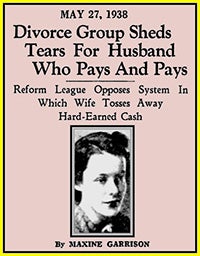 Maxine Garrison (BA class of 1934) served as the managing editor of the Pitt News and as President of Xylon, the women’s honorary journalistic fraternity. She later went on to a successful career as a feature writer for the Pittsburgh Press. In 1934, she wrote an essay describing what it was like to go to class in the Cathedral of Learning while it was still under construction. “Symphony of Noise” was published in the Pittsburgh Journal.
Maxine Garrison (BA class of 1934) served as the managing editor of the Pitt News and as President of Xylon, the women’s honorary journalistic fraternity. She later went on to a successful career as a feature writer for the Pittsburgh Press. In 1934, she wrote an essay describing what it was like to go to class in the Cathedral of Learning while it was still under construction. “Symphony of Noise” was published in the Pittsburgh Journal.
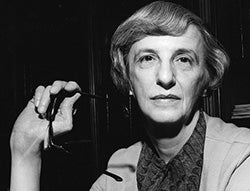 Gladys Schmitt (1909-1972) received her BA from our department in 1932. After graduation, she worked as an editor for Scholastic Magazine, first in Pittsburgh and then in New York. In 1942, she returned to Pittsburgh andjoinedthe faculty at Carnegie Mellon University (then Carnegie Tech). In 1942, she also published her first novel, The Gates ofAulis, which won the Dial Press Award for new fiction. Her second novel, David the King (1946) was a Literary Guild selection and a best-seller, both a critical and commercial success. Her other novels include Alexandra (1947), Confessors of the Name (a Literary Guild selection, 1952), The Persistent Image (1955), A Small Fire (1957), Rembrandt (a Literary Guild selection, 1961), Electra (1965), and The Godforgotten (1972). She published two children’s books—The Heroic Deeds of Beowulf, Retold and Boris, The Lopsided Bear—and a book of poems, Sonnets for an Analyst (1978). Schmitt attracted students and colleagues to CMU and in 1968, with Jerry Costanzo, she founded the CMU Creative Writing Program and established an undergraduate Writing major.
Gladys Schmitt (1909-1972) received her BA from our department in 1932. After graduation, she worked as an editor for Scholastic Magazine, first in Pittsburgh and then in New York. In 1942, she returned to Pittsburgh andjoinedthe faculty at Carnegie Mellon University (then Carnegie Tech). In 1942, she also published her first novel, The Gates ofAulis, which won the Dial Press Award for new fiction. Her second novel, David the King (1946) was a Literary Guild selection and a best-seller, both a critical and commercial success. Her other novels include Alexandra (1947), Confessors of the Name (a Literary Guild selection, 1952), The Persistent Image (1955), A Small Fire (1957), Rembrandt (a Literary Guild selection, 1961), Electra (1965), and The Godforgotten (1972). She published two children’s books—The Heroic Deeds of Beowulf, Retold and Boris, The Lopsided Bear—and a book of poems, Sonnets for an Analyst (1978). Schmitt attracted students and colleagues to CMU and in 1968, with Jerry Costanzo, she founded the CMU Creative Writing Program and established an undergraduate Writing major.
Murrel Wynn-Jones (BA 1931) was a well-known Pittsburgh artist.
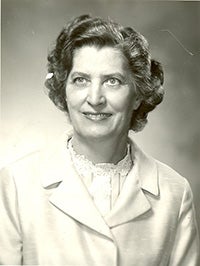 Marie Hochmuth Nichols (1908-1978) became an important figure in the fields of speech, rhetoric and communication. She received her BA from our department in 1931 and her MA in 1936. She completed her PhD at the University of Wisconsin (1945). She taught at Mount Mercy College for Women (1935-39) and then at the University of Illinois from 1939 until her retirement in 1976. Nichols served as the editor of the Quarterly Journal of Speech (1963-65) and as President of the Speech Association of America (1969). In the 1950s, she was one of the first to write on Kenneth Burke and I.A. Richards as fundamental figures in the “new rhetoric.” (See, for example: “Kenneth Burke and the ‘New Rhetoric’,” Quarterly Journal of Speech (January 1952.) With her former teacher, Wayland Maxfield Parrish, she published American Speeches (1969). Her most important book is Rhetoric and Criticism.
Marie Hochmuth Nichols (1908-1978) became an important figure in the fields of speech, rhetoric and communication. She received her BA from our department in 1931 and her MA in 1936. She completed her PhD at the University of Wisconsin (1945). She taught at Mount Mercy College for Women (1935-39) and then at the University of Illinois from 1939 until her retirement in 1976. Nichols served as the editor of the Quarterly Journal of Speech (1963-65) and as President of the Speech Association of America (1969). In the 1950s, she was one of the first to write on Kenneth Burke and I.A. Richards as fundamental figures in the “new rhetoric.” (See, for example: “Kenneth Burke and the ‘New Rhetoric’,” Quarterly Journal of Speech (January 1952.) With her former teacher, Wayland Maxfield Parrish, she published American Speeches (1969). Her most important book is Rhetoric and Criticism.
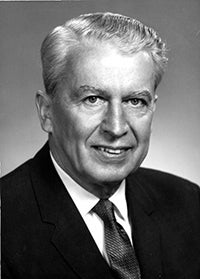 John Gerber (BA 1929; MA 1932) taught in our department as an instructor from 1931-1936, when he left to pursue a PhD at the University of Chicago (1941). In 1944, he joined the faculty at the University of Iowa, where he taught American literature and helped to establish and direct the Communication Skills program. Gerber went on to a distinguished career at Iowa, serving as department head from 1961-1976. At his retirement in 1976, he was the M.F. Carpenter Professor of English. He came out of retirement to chair the English department at SUNY-Albany until 1984. Gerber helped to define English for the post-war American university. He served as the President of NCTE in 1955. He was a founding member of the Conference on College Composition and Communication and served as its Chair in 1950. He served on the MLA Executive Council (1972-75) and as Chair of ADE (1964). He was the head of Project English (1964-65) for the US Department of Education. He was the first recipient of the MLA/ADE Francis Andrew March Award (1984) for distinguished service to the profession. He wrote on Emerson, Hawthorne, Melville and Twain. He chaired the editorial board for the Iowa-California edition of the works of Mark Twain and edited the volume, Tom Sawyer. After his retirement, he published a history of the University of Iowa and a history of its English department.
John Gerber (BA 1929; MA 1932) taught in our department as an instructor from 1931-1936, when he left to pursue a PhD at the University of Chicago (1941). In 1944, he joined the faculty at the University of Iowa, where he taught American literature and helped to establish and direct the Communication Skills program. Gerber went on to a distinguished career at Iowa, serving as department head from 1961-1976. At his retirement in 1976, he was the M.F. Carpenter Professor of English. He came out of retirement to chair the English department at SUNY-Albany until 1984. Gerber helped to define English for the post-war American university. He served as the President of NCTE in 1955. He was a founding member of the Conference on College Composition and Communication and served as its Chair in 1950. He served on the MLA Executive Council (1972-75) and as Chair of ADE (1964). He was the head of Project English (1964-65) for the US Department of Education. He was the first recipient of the MLA/ADE Francis Andrew March Award (1984) for distinguished service to the profession. He wrote on Emerson, Hawthorne, Melville and Twain. He chaired the editorial board for the Iowa-California edition of the works of Mark Twain and edited the volume, Tom Sawyer. After his retirement, he published a history of the University of Iowa and a history of its English department.
Charles Crow (BA 1930; MA 1931; PhD 1948) would have a long, distinguished and influential career in the English department at the University of Pittsburgh. We will provide a full biography of Charles Crow in the 1950s Faculty page.
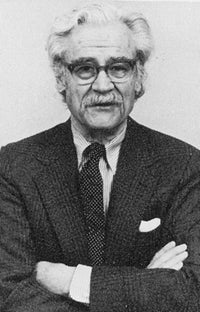 Robert C. Alberts (BA 1930) is the author of the bicentennial history, Pitt: The Story of the University of Pittsburgh, 1787-1987. Alberts began to write after retiring as a Vice-President of the public relations firm, Ketchum, MacLeod and Grove. He specialized in 18th century American history. His books include The Most Extraordinary Adventures of Major Robert Stobo (1965), The Golden Voyage: The Life and Times of William Bingham, 1752-1804 (1970), The Good Provider: H.J. Heinz and His 57 Varieties (1973), Benjamin West: A Biography (1978), and The Shaping of the Point: Pittsburgh’s Renaissance Park (1980).
Robert C. Alberts (BA 1930) is the author of the bicentennial history, Pitt: The Story of the University of Pittsburgh, 1787-1987. Alberts began to write after retiring as a Vice-President of the public relations firm, Ketchum, MacLeod and Grove. He specialized in 18th century American history. His books include The Most Extraordinary Adventures of Major Robert Stobo (1965), The Golden Voyage: The Life and Times of William Bingham, 1752-1804 (1970), The Good Provider: H.J. Heinz and His 57 Varieties (1973), Benjamin West: A Biography (1978), and The Shaping of the Point: Pittsburgh’s Renaissance Park (1980).
Rachel MacMaster Moodie (Lowrie)—BA 1933; MA 1946—taught for 30 years in the English department at Iowa State University, from 1949-1979. She taught first year composition throughout her career; she also developed a course in fiction writing, and she taught advanced courses in Romantic and Victorian British literature. In 1975, she was named “Teacher of the Year.”
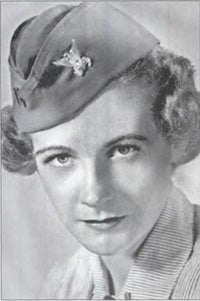 Helen Louise McGuffie (MA 1937). McGuffie spent time at Oxford and completed her PhD at Columbia. In 1947, she joined the faculty at her alma mater, Bethany College, where she had a long career (1947-1983) including two terms as department chair: 1954-74 and 1977-80. In her honor, the college established the Helen Louise McGuffie Lecture fund, which brings writers and scholars annually to campus for a lecture or a reading. McGuffie was the author of essays and reviews and a book, Samuel Johnson in the British Press, 1749-1784: A Chronological Checklist (1976). In World War II she served with the Coast Guard and remained with the Reserves until 1975, when she retired at the rank of Commander.
Helen Louise McGuffie (MA 1937). McGuffie spent time at Oxford and completed her PhD at Columbia. In 1947, she joined the faculty at her alma mater, Bethany College, where she had a long career (1947-1983) including two terms as department chair: 1954-74 and 1977-80. In her honor, the college established the Helen Louise McGuffie Lecture fund, which brings writers and scholars annually to campus for a lecture or a reading. McGuffie was the author of essays and reviews and a book, Samuel Johnson in the British Press, 1749-1784: A Chronological Checklist (1976). In World War II she served with the Coast Guard and remained with the Reserves until 1975, when she retired at the rank of Commander.
Ernest N. Dilworth (MA 1937) completed his PhD at Columbia and joined the faculty at Lehigh University, where he taught for 28 years, retiring in 1977. He was the author of The Unsentimental Journey of Lawrence Stern and, for the Twayne’s English authors series, Walter Savage Landor. He edited and translated Voltaire’s Philosophical Letters and Boileau’s Selected Criticism. He served as a Secretary of the AAUP.
Charles W.L. Foreman (BA 1935, MA 1938) taught speech and theater courses at Pitt after his graduation before serving as a Captain in the US Army in the European Theater. After the war, Foreman joined UPS and rose to Senior Vice President. As an administrator and trustee of the UPS Foundation, he played a major role in the establishment of endowments at several major research universities. He was Chairman of the Board of Trustees of the Independent College Funds of America, now the Foundation for Independent Higher Education. FIHE, with the Council of Independent Colleges, gives an annual Charles Foreman Leadership Award to a college president or corporate trustee. Foreman served as a trustee and chairman of strategic planning at Hartwick College in Oneonta, NY, where he helped to revise the liberal arts curriculum, and where he was given an honorary doctorate in 1989.
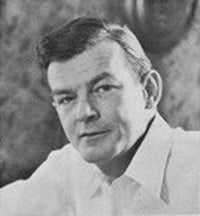 Robert Musser Brown (BA 1939) became Senior Vice-President of Ketchum, MacLeod and Grove, a large Pittsburgh advertising agency. In 1960 he published his first and only novel, Brother, Which Drummer? (Harcourt, Brace & Co), a business novel about a sales manager pushing his way to the top. The New York Times reviewer said that it was “a tour de force, a ‘problem novel that is also a parable for our time.” In an interview with Pitt, the alumni magazine, Brown, who recalled both Percival Hunt and Edwin Peterson, said, “I knew I had to write a novel.”
Robert Musser Brown (BA 1939) became Senior Vice-President of Ketchum, MacLeod and Grove, a large Pittsburgh advertising agency. In 1960 he published his first and only novel, Brother, Which Drummer? (Harcourt, Brace & Co), a business novel about a sales manager pushing his way to the top. The New York Times reviewer said that it was “a tour de force, a ‘problem novel that is also a parable for our time.” In an interview with Pitt, the alumni magazine, Brown, who recalled both Percival Hunt and Edwin Peterson, said, “I knew I had to write a novel.”
Wilson Borland (MA 1930) became the Executive Director of the Pittsburgh Housing Association and responsible for public housing in the Hill District.
Milton Lehman (BA 1939) was given a citation by the U.S. Army for distinguished journalism. He published essays and articles in the Saturday Evening Post, Life Magazine, Reader’s Digest, Colliers, Cosmopolitan, Esquire, and the New York Times Magazine. He had a long career as a writer for U.S. government office of Health, Education and Welfare, where he was given a distinguished award for service. He was the author The High Man: the Life of Robert Goddard (1963).
1930s PhD Graduates
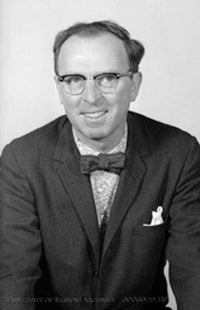
Richard Murphy (PhD 1939). Murphy was a radio announcer for KDKA when he joined the department as an Instructor of Public Speaking in 1927. He taught public speaking and coached the Pitt Debate Team. Murphy left in 1935-36 to do graduate work at Cornell. When he returned, his position was not renewed, some believed because of his political leanings, although Murphy would not confirm this. The failure to renew his contract, however, was the last straw for his mentor, Wayland Maxfield Parrish, who left for the University of Illinois. Murphy completed his PhD in our department in 1939 with a dissertation on “Alexander Smith: Man of Letters.” He taught at the University of Colorado before joining Parrish at Illinois in 1945, where he had a long and successful career (1945-1971). Murphy published widely in the areas of speech and communication. A portion of his dissertation (“Alexander Smith on the Art of the Essay”) is published in If By Your Art (1948), the tribute volume to Percival Hunt.
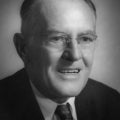 Thomas Matthews Pearce, Jr. (1902-1986). Thomas Matthews Pearce (BA Montana, 1923) received his MA (1925) and PhD (1930) from our department (with a dissertation on “Marlowe’s Tragedie of Dido in Relation to Its Latin Source”). He joined the English department at the University of New Mexico in 1924, where he taught for 37 years until his retirement in 1964. He chaired the UNM department from 1929-1951. His contributions to the state were celebrated when Governor Apodaca proclaimed May 8th, 1976, “T.M. Pearce Day.” He published essays on Shakespeare, Marlowe and Beowulf, but he is best known for his work on the literature of the American Southwest. He published three books on the Santa Fe writer, Mary Austin: The Beloved House (1940), Mary Hunter Austin (1965), and The Mary Austin Letters (1979). Pearce served as the first editor of The New Mexico Quarterly and was one of the founders of the New Mexico Folklore Society. His other books include American in the Southwest; Southwest Heritage: A Literary History with Bibliography (with Mabel Major and Rebecca S. Smith); Southwesterners Write; Signature of the Sun; Oliver La Farge; Lane of the Llano; Stories of the Spanish Southwest (a bilingual edition); and New Mexico Place Names: A Geographical Dictionary.
Thomas Matthews Pearce, Jr. (1902-1986). Thomas Matthews Pearce (BA Montana, 1923) received his MA (1925) and PhD (1930) from our department (with a dissertation on “Marlowe’s Tragedie of Dido in Relation to Its Latin Source”). He joined the English department at the University of New Mexico in 1924, where he taught for 37 years until his retirement in 1964. He chaired the UNM department from 1929-1951. His contributions to the state were celebrated when Governor Apodaca proclaimed May 8th, 1976, “T.M. Pearce Day.” He published essays on Shakespeare, Marlowe and Beowulf, but he is best known for his work on the literature of the American Southwest. He published three books on the Santa Fe writer, Mary Austin: The Beloved House (1940), Mary Hunter Austin (1965), and The Mary Austin Letters (1979). Pearce served as the first editor of The New Mexico Quarterly and was one of the founders of the New Mexico Folklore Society. His other books include American in the Southwest; Southwest Heritage: A Literary History with Bibliography (with Mabel Major and Rebecca S. Smith); Southwesterners Write; Signature of the Sun; Oliver La Farge; Lane of the Llano; Stories of the Spanish Southwest (a bilingual edition); and New Mexico Place Names: A Geographical Dictionary.
Isaac Clayton Keller. (PhD 1932; diss: “Thomas Buchanan Read”). Keller took a position at California State Teachers College, now California University of PA.
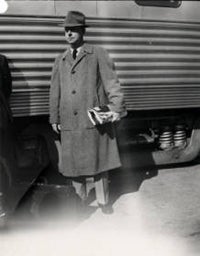 Clarke Olney. (PhD 1933; diss: “Benjamin Robert Haydon as a Figures in the Romantic Movement in English Literature”). Olney went to the University of Miami in 1938, where he achieved the rank of Professor. Later, he moved to the University of Georgia.
Clarke Olney. (PhD 1933; diss: “Benjamin Robert Haydon as a Figures in the Romantic Movement in English Literature”). Olney went to the University of Miami in 1938, where he achieved the rank of Professor. Later, he moved to the University of Georgia.
Georgia Gantt-Winn. (PhD 1939; diss: “Works of Henry Blake Fuller”). Gantt-Winn became the Chair of the English department at Sul Ross College, Alpine, Texas, where a scholarship bears her name.
Katherine Gillette Blyley (PhD 1937; diss: “Marietta Holley”). Blyley taught at Skidmore, at Thiel, and then became English department chair, Dean, and first woman President (1947-1958) at Keuka College, Canandaigua, NY.
Russell Sedden Burkhart (PhD 1935; diss: “The Syntax of Place in Old English Prose”). Burkhart taught at Ball State Teachers College.
Other 1930s PhDs
Wolfe, Don Marion. “Milton and the Theory of Democracy” (1930)
Berry, Iona Richmond. “Barclay’s Ship of Fools as a Reflection of Early Sixteenth Century England” (1931)
Anderson, Mary R. “Harriet Martineau, a Representative Didactic Writer of the Nineteenth Century” (1932)
Schnurer, Clara. “Mrs. Gaskell’s Fiction” (1932)
Woodall, Allen Earl. “William Joseph Snelling, 1804-1848: A Review of His Life and Writings” (1932)
Wright, John Ernest. “William Hale White (Mark Rutherford)” (1932)
Graham, Thomas Emerson. “Newman’s Ideal of Saintliness” (1933)
Stebbins, Henry Martin. “The Soldier in the English Novel” (1934)
Hamilton, Carson Crandall. “Wordsworth’s Decline in Poetic Power: The Conflict of the Supreme Power” (1935)
McKerahan, Annabelle Livingston. "Paradise Lost: A Sublimation of the Philosophical Concepts Found in Milton’s Prose" (1936)
Eckler, Eric Alexander. “Materials for the Study of William Hazlitt as a Social Critic” (1937)
Bailey, Mary Matilda. “Mark Twain and the Fine Arts” (1938)
Fisher, Henry Clayton. “Realism and Morality in English Fiction up to 1750” (1938)
1930s Footnotes

Chancellor Bowman and Robert Frost
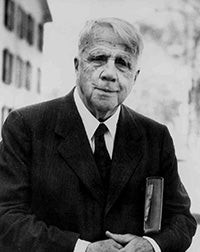
Robert Frost
In 1937, with the support of Percival Hunt, Chancellor Bowman wrote to Robert Frost to see if he had any interest in coming to Pittsburgh for a visit, with the hope that Frost might be persuaded to join the faculty. The letters are surprisingly eloquent exercises in style and self-definition. Bowman is not to be underestimated and Frost not to be outdone. Bowman speaks of the arts; Frost of football.
On September 23, 1937, Bowman wrote:
Dear Mr. Frost:
Once upon a time we had some talk. Part of it was about the possibility of your coming to Pittsburgh. We are now vastly more ready to attempt seriously to resolve this Pittsburgh community to an essence; in other words, to say by means of painting, sculpture, poetry, or other arts, what David once said about his land, when he told his people that the Lord was his shepherd. The twenty-third psalm is an essence of the Land of Judaea. Perhaps if we could do as much for this Pittsburgh district we should discover what education is for.
Could you find time to spend a day with me, at our expense, in Pittsburgh. If not, maybe you would invite me to see you at some reasonably convenient place, like New York. The idea in mind is that you come and live with us and we’ll do our best to make you glad you came.
With kind personal wishes, I am
Faithfully yours,
Frost’s hand written reply is dated Amherst, Mass; November 7, 1937. He says:
Dear Mr. Bowman:
All things considered a long time, we think we are too old for a new social venture: which is what it would mean if we came to Pittsburg and what it ought to mean. Mrs. Frost has just been through a very serious operation that makes us both feel our age with sudden force. She is not up to entertaining much anymore or even to being entertained; and for me, I couldn’t undertake anything important that she couldn’t hope to have at least some small part in.
I have thought of you often in heart-felt sympathy with the great big American thing you are doing for the city of Pittsburgh. Too bad I couldn’t have been called to share in it twenty or thirty years ago. I am no reformer and no social service worker. I’d rather do things well than do people good. But I should have liked nothing better than to spend time where the brave and none too privileged were girding themselves for struggle. I enjoy your mighty football teams if only as a symbol of that struggle. I trust the love I have sent you by friends once or twice has reached you with effect. Your success is on my mind.
Sincerely yours,
Jock Sutherland and William Don Harrison
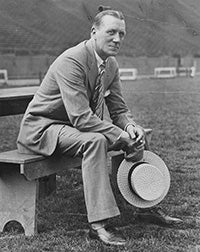
Jock Sutherland
William Don Harrison, an Associate Professor of English and the former Dean of Men, was named Athletic Director in 1928 by the Chancellor, John G. Bowman. Harrison was in charge, then, during the peak years of the Jock Sutherland era, an era that included a win at the Rose Bowl in 1937, national success in basketball, track and swimming. This was a time when Pitt was trying to position itself to replace Chicago in the Big Ten. Harrison would resign the position in 1937, when, representing the Chancellor, he and Sutherland were locked in a battle over money to support athletics--a battle over the sources as well as the levels of funding.
There was a history of bad feeling between Sutherland and Harrison. According to Sutherland, Harrison once said to him, “I made you and I can break you.” Sutherland felt, with some justification, that he and his players were not receiving the kind of support they needed to continue to compete at the highest level. The university alumni took Sutherland’s side and, in 1937, the executive committee of the Athletic Council (an alumni group) prepared a report to resolve the conflict and presented it to Harrison. The Chancellor and Harrison resented the pressure from the alumni council. In the face of their demands, and to try to forestall controversy on campus, Harrison chose to resign, saying, however, “Such a situation should, under no circumstances, exist in any department in the University.” James Hagan, who had played football for Pitt, took his place as A.D. With Chancellor Bowman, Hagan prepared a plan that became known as the “Hagan Plan” and then later, by 1938, the “Bowman Code.” Under this “Code of Conduct for Athletics,” there would be no scholarships awarded on the basis of athletic ability, and the alumni were forbidden to provide gifts or private assistance to university athletes.
In response, Jock Sutherland submitted his letter of resignation, which the Chancellor accepted. This was in the Spring of 1939. The disagreement between Harrison and Sutherland created substantial controversy and attracted the attention of the national press. After his resignation, Harrison left Oakland to teach at the University’s Erie extension campus and then at Johnstown. He remained on department’s faculty roster. Sutherland went on to coach professional football with the Brooklyn Dodgers and, from 1946 until his sudden death in 1948, the Pittsburgh Steelers.
Credits
The images of Wayland Maxfield Parrish and Richard Murphy are courtesy of the University of Illinois Archives, Faculty, Staff and Student Portraits, RS 39/2/26.
The photograph of Thomas Matthews Pearce, Jr. comes from the Thomas M. Pearce Pictorial Collection (PICT 000-255-0012), Center for Southwest Research, University Libraries, University of New Mexico. Accessed online, http://econtent.unm.edu/.
